Since its development in 2008 by American company Varien, open source CMS Magento has become the world’s leading e-commerce platform. However, he doesn’t have the monopoly on the market: he is followed closely by PrestaShop, an open source CMS created in 2007 by five French students which is the leading e-commerce platform in France. Online merchants often find it hard to choose between these two robust, reliable and scalable platforms. Here are a few comparison points to help you determine which one is best suited for your project.

Power
Magento is the ideal choice if you are looking for a tool which can manage voluminous product catalogs and withstand high traffic: it can handle an unlimited number of products and can process more than 80,000 orders per hour–as long as you use the appropriate hosting plan. However, if you choose to use Magento 1, note that you will most probably encounter slowness issues. This is not the case for Magento 2 which comes with a built-in full page cache component and Varnish support.
In comparison with Magento 1, PrestaShop is faster. With regard to the catalog, PrestaShop can handle as many products as you want, just as its competitor. Nonetheless, it only provides optimal performance up to a certain number of products and visitors, at which point you will have to use a dedicated server. If your online shop has a large product catalog and receives a high number of visitors, you might want to consider choosing Magento, which is best suited for large-sized e-commerce websites.
Functional richness
With more than 310 built-in features, PrestaShop is complete enough to enable you to create and handle an e-commerce efficiently. The features offered notably include catalog, orders and clients management as well as multistore, statistics, marketing and SEO functionalities. If your online store requires a higher degree of customization, note that more than 5,000 addons are available for purchase on PrestaShop’s marketplace. To this day, PrestaShop is available in 65 languages.
On this point, Magento takes the lead: it is available in more than 81 languages. Its features are more or less the same as the ones PrestaShop offers. However, they are more advanced, thus making Magento more difficult to take in hand. It notably offers better SEO optimization and product management than PrestaShop. Magento has its very own marketplace, Magento Connect, where you can choose among the 9,000+ available addons.
Accessibility
As regards the installation process, Magento and PrestaShop have nothing to envy each other: it is easy and quick in both cases. Their accessibility is what really makes the difference.
PrestaShop comes with an intuitive administration interface which makes it easy to use and particularly adapted to novices. Moreover, it is easily customizable, a major advantage over Magento.
Magento’s complex architecture requires advanced technical skills and a familiarization period to be able to master the tool properly.
Community
Support from the community is essential to ensure the sustainability of an e-commerce platform. By doing regular updates and corrections, users provide constant technical support for fast troubleshooting.
PrestaShop’s community is made up of more than 700,000 members, mainly francophone, who are active on various help forums on a daily basis. It is therefore richly-documented, and especially in French.
Magento has a community of over 600,000 members who maintain different websites dedicated to it and regularly provide improvements.
Budget
Good news for those with a small budget: PrestaShop and Magento both have a free edition. Magento also has an Enterprise edition which costs around 15,500$ and adds a few extra features as well as support from expert Magento consultants, but many big businesses settle for the free Community version and are perfectly happy with it.
Even though PrestaShop and Magento offer free versions, they still entail development costs. Building an e-shop with PrestaShop is easy: it is less complex and technical than Magento, which requires a higher level of expertise and the help of a professional (whom you will obviously have to pay). However, Magento’s technical debt is lower than PrestaShop’s: for instance, PrestaShop does not handle namespaces or automated testing. Its codebase is currently being modernized with the development of PrestaShop 1.7, but it is still unknown exactly when the first stable version will be released. For its part, Magento is more modern, especially now that Magento 2 is on the market.
But what about features? PrestaShop offers free modules and themes but most addons, even common features, require payment: as a result, the bill will rise for e-shops that require extended customization. Magento provides more free addons than PrestaShop, though some must obviously be paid for.
Hosting also need to be taken into account. Magento is a heavy, resource-intensive solution; that is why it is recommended to use a dedicated server. PrestaShop can work with a shared hosting web service, a cheaper alternative, as long as the online store isn’t too large and complex.
PrestaShop is therefore globally cheaper than Magento.
You will have understood that the real question surrounding Magento and PrestaShop is not “which one is the best?” but rather “which one is best suited for my project?”. With its simple and intuitive ergonomics, PrestaShop is the perfect option for small-scale projects. Larger e-shops will prefer Magento, more complex but also more advanced.
The decision is now in your hands!
